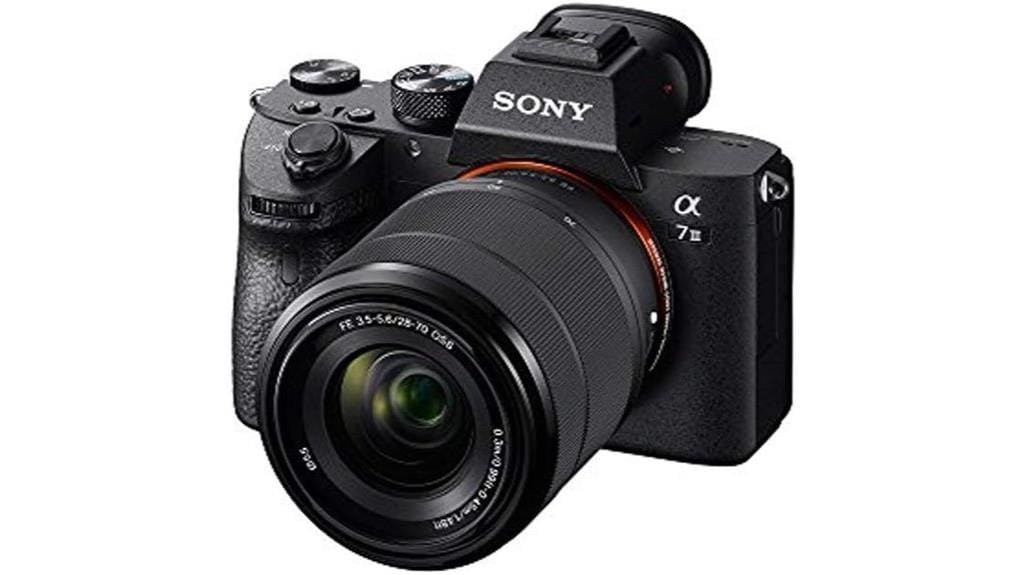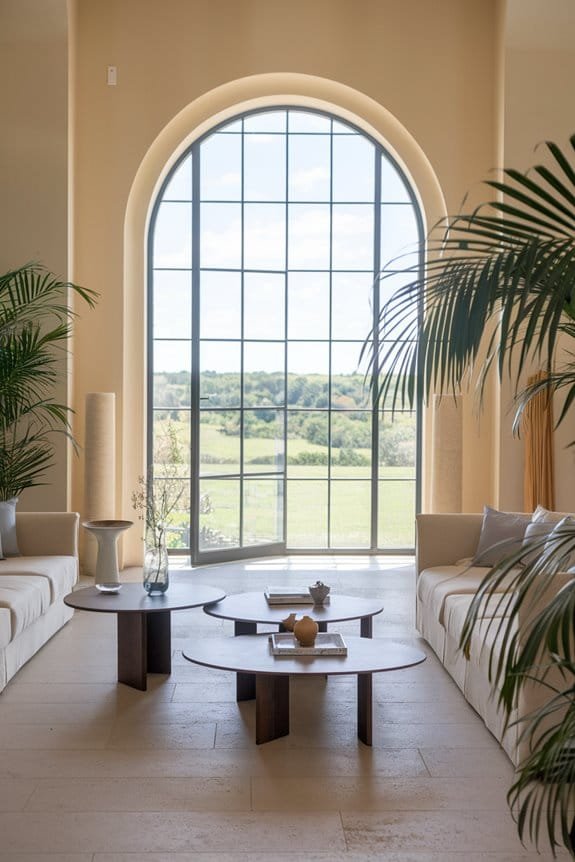The Sony A7 III is indeed a game changer in photography, featuring a 24.2MP full-frame sensor that delivers exceptional image quality and dynamic range. This model boasts an advanced autofocus system with 693 phase-detection points, ensuring quick and accurate focus even in challenging conditions. Its impressive low-light capabilities, thanks to the back-illuminated sensor, make it ideal for night photography and events. The camera’s compact design enhances portability, while the improved battery life accommodates longer shooting sessions. However, some users express concerns about the single UHS-II card slot and the kit lens quality, areas where future iterations could improve. Further insights reveal even more about its capabilities and user experiences.
- Advanced 24.2MP BSI Full-frame Image Sensor w/ 1.8X readout speed*Advanced 24.2MP Back-Illuminated 35mm Full-frame Image…
- 15-stop dynamic range, 14-bit uncompressed RAW, ISO 50 to 204,800
- Up to 10fps Silent or Mechanical Shutter with AE/AF tracking
Key Takeaways
- The A7 III features a 24.2MP BSI sensor, delivering exceptional image quality and outstanding low-light performance with a dynamic range of 15 stops.
- Its advanced autofocus system boasts 693 phase-detection and 425 contrast points, ensuring fast and accurate focusing in various conditions.
- The camera’s compact design enhances mobility, making it an ideal choice for photographers on the go.
- Users appreciate the improved battery life, allowing for extended shooting sessions without frequent recharging.
- Despite limitations like a single card slot and mixed reviews for the kit lens, overall performance and image quality garner high satisfaction.
4.2mp Full-Frame Sensor
The Sony A7 III features a 24.2MP BSI Full-frame Exmor R CMOS sensor, which stands out for its impressive image quality and dynamic range.
This sensor is designed to capture stunning detail and color accuracy, making it ideal for a wide variety of photography styles, from landscapes to portraits.
With a dynamic range of 15 stops, the A7 III excels in low-light conditions and highlights, allowing photographers to achieve remarkable results even in challenging lighting scenarios.
Additionally, the sensor’s back-illuminated design contributes to enhanced performance at high ISO settings, ranging from 50 to 204,800, further demonstrating its versatility.
This combination of specifications not only elevates the A7 III in the mirrorless camera market but also signifies a significant leap forward for professional photographers.
Pros and Cons
In evaluating the Sony A7 III, it is essential to take into account both its advantages and disadvantages to provide a thorough understanding of its performance.
This camera shines with its impressive autofocus capabilities, excellent low-light performance, and robust battery life, making it a strong contender for both enthusiasts and professionals.
However, potential buyers should also be aware of its limitations, such as the only single UHS-II card slot and the average quality of the included kit lens, which may influence their decision.
Pros
One of the standout features of the Sony A7 III is its exceptional autofocus system, which includes 693 phase-detection and 425 contrast AF points, providing an impressive 93% image coverage. This advanced system guarantees rapid and precise focusing, making it ideal for capturing fast-moving subjects.
Additionally, the camera boasts a remarkable 24.2MP BSI full-frame sensor, delivering stunning image quality and a dynamic range of 15 stops, perfect for various lighting conditions. Users will also appreciate its impressive ISO range of 50 to 204,800, which enhances low-light performance considerably.
The A7 III’s compact design facilitates mobility, while the improved battery life and ergonomics further enhance its usability, making it a compelling choice for both enthusiasts and professionals alike.
Cons
While the Sony A7 III excels in numerous areas, certain drawbacks merit consideration.
Particularly, the camera features only a single UHS-II card slot, which may limit storage options for professionals requiring extensive shooting. Additionally, the kit lens, SEL2870, has received mixed reviews for its performance, often falling short compared to higher-end alternatives.
Users have also pointed out that the touchscreen functionality is restricted solely to focusing, which can be frustrating for those seeking a more interactive experience.
Finally, while battery life has improved, it still may not be sufficient for long shooting sessions without a backup.
These limitations, albeit minor in the grand scheme, deserve attention from potential buyers weighing their options.
Detailed Features
Packed with advanced technology, the Sony A7 III stands out in the competitive mirrorless camera market.
Featuring a 24.2MP BSI Full-frame Exmor R CMOS sensor, it delivers exceptional image quality with a dynamic range of 15 stops, catering to both photography enthusiasts and professionals.
The ISO range extends from 50 to an impressive 204,800, allowing for outstanding low-light performance.
Its autofocus system boasts 693 phase-detection points and 425 contrast points, ensuring rapid and precise focusing across 93% of the frame.
With continuous shooting capabilities of up to 10 frames per second, capturing fast action is effortless.
Additionally, the camera supports 4K HDR movie recording, making it a versatile tool for videographers.
What People Are Saying About It
User feedback regarding the Sony A7 III highlights its impressive performance and features.
Many users commend the camera’s autofocus speed and accuracy, particularly in comparison to Canon DSLRs, making it a preferred choice for both enthusiasts and professionals.
The image quality is frequently praised, with reports of excellent stabilization and dynamic range, which enhances creative possibilities.
Battery life has also seen notable improvements over previous models, allowing for extended shooting sessions without interruption.
However, some users have pointed out limitations, such as the single UHS-II card slot and the mediocre performance of the included kit lens.
Exceptional Low-Light Capabilities
The Sony A7 III is renowned for its exceptional low-light capabilities, making it an invaluable tool for photographers who often work in challenging lighting conditions.
With a 24.2MP BSI full-frame sensor and an impressive ISO range of 50 to 204,800, this camera excels in situations where light is scarce. The sensor’s design allows for improved light sensitivity, greatly reducing noise even at higher ISO settings.
Additionally, the camera’s dynamic range of 15 stops guarantees that both highlights and shadows are captured with remarkable detail.
Users have reported that the A7 III outperforms its predecessors, including the a9 and a7R III, in low-light scenarios, making it a standout choice for event, portrait, and night photography.
- Prepare for Loan Maturities and Refinancing Waves as a Real Estate AgentIn mastering loan maturities and refinancing waves, uncover strategies every real estate agent needs to empower clients during pivotal financial transitions.
Bottom Line
Considering its impressive features and performance, the Sony A7 III stands out as a top-tier choice for both amateur and professional photographers.
With its 24.2MP full-frame sensor, exceptional autofocus system, and remarkable low-light capabilities, this camera delivers stunning image quality that rivals more expensive models.
The continuous shooting speed of 10 frames per second guarantees that you won’t miss critical moments, while the 4K HDR video recording adds versatility for videographers.
Although it has some limitations, such as a single UHS-II card slot and a kit lens that underperforms, the overall value offered by the A7 III is unparalleled.
To summarize, it’s a game changer that elevates the photographic experience, making it a worthwhile investment for any serious enthusiast.
Frequently Asked Questions
Recent Posts

How to Meet Your Continuing Education Requirements as a Real Estate Agent

Why Company Culture Matters When Choosing a Brokerage
Is the Sony A7 III Suitable for Beginner Photographers?
The Sony A7 III is indeed suitable for beginner photographers due to its user-friendly interface and impressive autofocus system.
With a 24.2MP full-frame sensor, it delivers excellent image quality, while its range of ISO settings enhances low-light performance.
The camera’s compact design and improved ergonomics contribute to a comfortable shooting experience.
Additionally, the inclusion of a versatile lens and a robust battery life further supports newcomers in their photographic journey, making it an appealing choice.
Can I Use My Canon Lenses With the A7 III?
Yes, you can use Canon lenses with the Sony A7 III by employing a suitable lens adapter.
These adapters allow you to mount Canon EF or EF-S lenses onto the Sony full-frame body, enabling you to leverage your existing lens collection.
However, it is important to note that using an adapter may affect autofocus performance and image stabilization, so it’s advisable to research specific adapters for best compatibility and performance with your desired lenses.
What Is the Weight of the Sony A7 III?
The weight of the Sony A7 III is approximately 650 grams (1.43 pounds) with the battery and memory card included.
This relatively lightweight design makes it suitable for photographers who require mobility without compromising on performance.
Its compact form factor, combined with a sturdy build, allows for extended use in various shooting conditions, enhancing the user experience.
This balance of weight and functionality positions the A7 III as a compelling choice among full-frame cameras.
How Does the A7 III Perform for Wildlife Photography?
The Sony A7 III excels in wildlife photography due to its exceptional autofocus system, featuring 693 phase-detection points, which guarantees swift and accurate tracking of moving subjects.
Its impressive low-light performance, with an ISO range of 50 to 204,800, allows for versatile shooting conditions.
Additionally, the camera’s continuous shooting capability of up to 10 frames per second enables photographers to capture fleeting moments effectively, making it a reliable choice for wildlife enthusiasts.
Does the Camera Come With a Memory Card?
The Sony A7 III does not include a memory card as part of its standard package.
While the camera comes equipped with essential accessories such as a lens, battery, and AC adapter, users will need to purchase a compatible memory card separately to store images and videos.
It is advisable to select a high-speed UHS-II card to fully utilize the camera’s capabilities, particularly for high-resolution images and 4K video recording.
Bottom Line
To summarize, the Sony A7 III stands out as a groundbreaking mirrorless camera, combining advanced technology with user-friendly features. Its impressive 24.2MP sensor, exceptional autofocus system, and versatile video capabilities cater to a wide range of photographic and videographic needs. Additionally, the camera’s outstanding low-light performance and robust design make it a compelling choice for both amateurs and professionals. As a result, the A7 III has solidified its reputation as a game changer in the digital imaging landscape.








